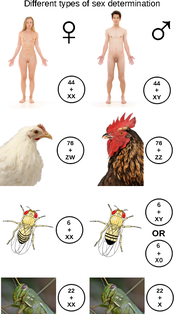
A sex-determination system is a biological system that determines the development of sexual characteristics in an organism.[1] Most organisms that create their offspring using sexual reproduction have two common sexes and a few less common intersex variations.
In some species, there are hermaphrodites, i.e., individuals that can function reproductively as either female or male.[2]
There are also some species in which only one sex is present, temporarily or permanently. This can be due to parthenogenesis, the act of a female reproducing without fertilization. In some plants or algae the gametophyte stage may reproduce itself, thus producing more individuals of the same sex as the parent.
In some species, sex determination is genetic: males and females have different alleles or even different genes that specify their sexual morphology. In animals this is often accompanied by chromosomal differences, generally through combinations of XY, ZW, XO, ZO chromosomes, or haplodiploidy. The sexual differentiation is generally triggered by a main gene (a "sex locus"), with a multitude of other genes following in a domino effect.
In other cases, sex of a fetus is determined by environmental variables (such as temperature). The details of some sex-determination systems are not yet fully understood. Hopes [who?] for future fetal biological system analysis include complete-reproduction-system initialized signals that can be measured during pregnancies to more accurately determine whether a determined sex of a fetus is male, or female.[citation needed] Such analysis of biological systems could also signal whether the fetus is hermaphrodite, which includes total or partial of both male and female reproduction organs.
Some species such as various plants and fish do not have a fixed sex, and instead go through life cycles and change sex based on genetic cues during corresponding life stages of their type. This could be due to environmental factors such as seasons and temperature. In some gonochoric species, a few individuals may have sex characteristics of both sexes, a condition called intersex.[3]
- ^ Schnebly, Risa Aria (2021). "Sex Determination in Humans". The Embryo Project Encyclopedia. Retrieved 6 July 2022.
- ^ Rosenfield KA (2018). "Hermaphrodite". In Vonk J, Shackelford T (eds.). Encyclopedia of Animal Cognition and Behavior. Cham: Springer International Publishing. pp. 1–2. doi:10.1007/978-3-319-47829-6_329-1. ISBN 978-3-319-47829-6.
- ^ Minelli A, Fusco G (2019). The Biology of Reproduction. Cambridge University Press. pp. 116–117. ISBN 978-1108499859. Archived from the original on 11 October 2020. Retrieved 11 October 2020.